|
CONTENTS
Even 12th Man Couldn't Stop "Old 98"
Another "Choo Choo"
Football Survives at BC
Spurrier Wants the Record
Giants Acquire Tittle, Trade Huff
Big Thursday
Somebody Pulled the Plug
USC-ND Part I
USC-ND Part II
You Can't Stay on Our Team
Don't Kid in the Showers
Football
Stories – I
Football Stories –
II
Football
Stories – III
Football Stories – IV
Football Stories – V
Football Stories – VI
Football Stories - VII
Football Stories - VIII
Football Stories - X
Golden Football Magazine
Golden Rankings Home
Top
of Page
|
Interesting
Football Stories– IX
Even 12th Man Couldn't Stop "Old 98"
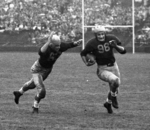 |
Tom Harmon was one of the greatest backs in history.
- At Michigan from 1938-40, he gained 2,134 yards, scored 33 TD and kicked 33 PAT as well as two FG for a total of 237 points. He also threw 16 TD passes on his way to the 1940 Heisman Trophy.
- He was the first player taken in the 1941 NFL draft by the Chicago Bears. However, he wasn't interested in pro ball at that time.
- After a fighter pilot career in World War II, he played for the Los Angeles Rams. War injuries hampered his effectiveness, and he retired after only two pro seasons.
- He married movie star Elyse Knox and became a nationally-known sports announcer. Actor Mark Harmon ("NCIS"), who played QB at UCLA, is his son.
|
The most curious incident of Harmon's football career occurred on September 28, 1940, in the season opener at California before 35,401. "Old 98" ran wild, scoring four TDs in the 41-0 victory.
- He started by running the opening kickoff back 94 yards.
- In Q2, he fielded a punt at his 28 and zigzagged to the end zone. Later in the period, he bolted 86 yards from scrimmage.
- Finally, after the first string sat out Q3, he returned in the final period to score on a short run and toss a 5-yard TD.
- Tom also kicked 4 extra points.
It was the third TD run that ended hilariously.
- As Harmon, far in the clear, approached the Cal goal line, a baldheaded man came out of the stands and tried to tackle Tom at the 2.
- A stiff arm and sidestep left the fan sprawled on the grass.
- Within a few seconds, two policemen escorted the inebriated man away.
Life magazine did a story on the incident that included an interview with the fan, Bud Brennan, a commercial artist and former high school lineman.
- "Harmon is coming like hell, and the California safety man has turned his back. There's only one human being in the entire stadium who can possibly touch him. That's me."
- "I left my feet and hauled him down as he crossed the goal line. Well, I almost did."
- "The kid looks at me kinda funny and says, 'What the hell do you think you're doing?' And I says, 'I'm tackling you.'"
- Brennan added, "I'm glad I did it. Anyway, when the Michigan guys go home, they can't tell folks nobody tackled Harmon. I did."
|
You may have heard of Charlie "Choo Choo" Justice, All-American RB for North Carolina 1946-9. But how about Gene "Chattanooga Choo Choo" Roberts? Ever heard of him? He took the NFL by storm and then just as quickly abandoned U.S. football.
Born in Kansas City MO, Gene Roberts played for Kansas and then Chattanooga (hence the nickname) where he made "Little All-America." His flakiness was apparent even then.
- The coach let him sit out scrimmages because Roberts said he played better on Saturdays that way.
- Also, in a crew cut era, he didn't cut his hair the entire season, playing with flowing locks to his shoulders.
The New York Giants drafted him in the eighth round in 1946. His four-year career with the Giants, which started slowly because of injuries, produced outstanding seasons in 1949 and 1950.
- He rushed for 634y and 9 TD and caught 35 passes for 711y and 8 TD in 1949.
- That same season, he led the NFL in scoring with 102 points. His 17 TD tied Pat Harder of the Chicago Cardinals for tops in the circuit.
- The New York Daily News named him 1st team all-NFL and the United Press International put him on the second team.
- His biggest day occurred the following year on November 12, 1950, against the Cardinals before a "disappointing crowd of only 22,380" in the Polo Grounds.
- The 5'11" 188 lb HB-FB scored 2 TDs on 61- and a 35-yard runs.
- Roberts amassed 218y rushing, an NFL record at the time.
- The Giants amassed a staggering 552y of offense, 309 on the ground and 243 in the air, in pulverizing the Cardinals 51-21.
- While Roberts' league record was broken six years later, his Giant record for most yards rushing in a game lasted until December 17, 2005, when Tiki Barber broke it.
- Choo Choo played in the inaugural Pro Bowl in Los Angeles after the 1950 season.
|
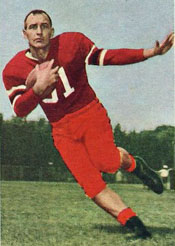
Gene "Choo Choo" Roberts |
1950 was Roberts' last in the NFL.
- In April 1951, he informed the Giants that he was retiring to devote himself to his ranch in Brazil!
- Then in July, New York, apparently not believing there was a ranch in Brazil, traded Roberts to the Green Bay Packers for a top choice in the next draft.
- However, he never played for the Packers.
- Instead, he signed with the Montreal Alouettes of the Big Four Football League (officially the "Interprovincial Rugby Football Union"), a forerunner of the Canadian Football League.
- According to Gene's son in a 2005 interview (after Tiki broke his record), his dad did not like the Mara family (owners of the Giants) because they underpaid their players. And in 1951 "no one wanted to go to Green Bay.
Waived by Montreal after the 1951 season, he signed with the Ottawa Rough Riders and played with them through 1954.
- In 1953, he led the league in scoring with 88 points, making him the answer to the trivia question, "Who is the only player to lead both the National and Canadian Football Leagues in scoring?"
- In 1954, Choo Choo played in the first Canadian game televised nationally in the U.S. Lindsey Nelson and former Notre Dame Four Horseman and coach Jim Crowley announced for NBC.
When Boston College fans left Fenway Park after their season-ending 7-0 loss to Holy Cross in 1956, most felt that an era had come to a close. As sports columnist Austen Lake of the Boston American reported: "A decision to drop football was imminent." What pushed BC to this precipice?
- Tom Yawkey, owner of the Red Sox, had decreed that he would no longer host any football games at Fenway because of the wear and tear on the field.
- Since World War II, BC had played its big games at Fenway because the school's Alumni Field, built in 1915, held only 5,000 spectators.
- The Eagles wouldn't be able to schedule major competitors at such a tiny stadium.
- BC had also used Braves Field for some big games, but the National League club had flown the coop to Milwaukee in 1953. Their 40,000-seat stadium had been acquired by Boston University.
The Eagles finished 5-4 in 1956 for their fourth straight winning season under Mike Holovak. So the team was holding its own on the field. However, the 1950s were a shakedown period in college football. Numerous private colleges had to decide whether to make the commitment to play big-time football, revert to a "small school" status, or even drop the sport. BC's sister Jesuit schools, Georgetown and Fordham, had already rolled back their programs.
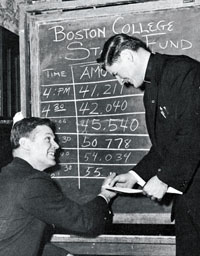
Athletic director Flynn and Fr. George Kerr track drive’s progress. |
BC's president, Joseph Maxwell, S.J., consulted the secretary of the alumni association, William J. Flynn, captain of the 1938 team who was now the line coach. "We could drop football," said Maxwell. "Or we could build a stadium," countered Flynn. Strapped for cash, the university finally decided its football future would hinge on a quarter-million capital campaign targeted at a new stadium.
In his new position as AD, Flynn spearheaded the campaign. One of the prominent alumni he enlisted to sell the idea was former All-American G George Kerr '41. Dubbed as the "righteous reject," he reported to coach Gil Dobie in 1938 wearing three sweaters and two overcoats so that he would weigh-in at 185. When it was discovered that his true weight was only 165, he was told he was too small for a football scholarship. Nevertheless, he stayed on the team as a walk-on and became a starter under Frank Leahy, who took over in 1939. Kerr was one of the leaders of BC's Sugar Bowl champions in his junior season. After graduation, Kerr entered the seminary and became a priest of the Archdiocese of Boston. By 1956, he was Monsignor George Kerr.
The Alumni Fund eventually exceeded its original goal, raising enough money to build not only a 25,000-seat stadium by start of the 1957-8 school year but eventually a gymnasium and hockey rink. It is no stretch to say that BC is the only other Catholic university playing Division I-A football today besides Notre Dame because of the great fundraising effort of 1956-7. |
|
Spurrier Wants the Record
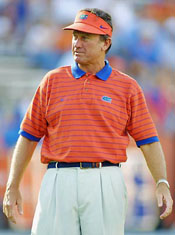
Steve Spurrier |
Steve Spurrier has often infuriated opposing coaches both with his comments before and after games and his decisions during games. Pepper Rodgers, a longtime opponent and colleague, once said, "Embarrassment is part of the game to him." This is illustrated by the 1995 Florida-Georgia game.
Florida visited Sanford Stadium in Athens that season as part of a two-year home-and-home contract during the renovation of the Gator Bowl, the traditional site of the World's Largest Cocktail Party. No opponent had ever scored 50 points "Between the Hedges." However, this was not the Bulldogs' day as they trailed by 28 points in the closing minutes. When Steve realized his team had a chance to top 50 for the first time ever, he called a pass to score a TD in the last two minutes to complete a 52-17 rout. The defeat was one of the last nails in the coffin of Bulldog coach Ray Goff (unaffectionately called "Ray Goof" by the Georgia faithful). He was replaced at the end of the season by Jim Donnan, who proceeded to lose to Florida 47-7, 38-7, and 30-14 during his five years in Athens. (He did win 37-17 in 1997.)
Spurrier undoubtedly remembered his own 0-3 record against Georgia as the Gator QB from 1964-6. Included was a 27-10 Dog win in 1966 when he was intercepted three times, more than he had suffered in Florida's first seven games that season, all wins.
|
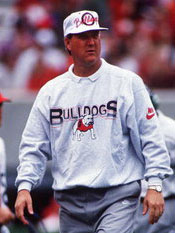
Ray Goff |
Reference: Football Feuds: The Greatest College Football Rivalries, Ken Rappoport & Barry Wilner
Top of Page
|
Giants Acquire Tittle, Trade Huff
The New York Giants were one of the top teams in the NFL in the 1950s and early 1960s. Here are stories of how they acquired a future Hall of Fame QB and how they traded away a Hall of Fame LB.
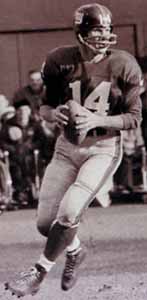
Y.A. Tittle |
- After graduating from LSU, QB Y.A. Tittle started his pro career with the Baltimore Colts in 1948 and 1949. No, not the later Colts of Weeb Ewbanks and Johnny Unitas but rather the Colts of the All-American Football Conference. He moved with the team into the NFL for the 1950 but wound up with the San Francisco 49ers from 1951-1961, toiling valiantly for generally poor teams. Before the start of the 1961 campaign, the Giants were in Salem OR to play the 49ers. The New York owner, Wellington Mara, told the defense in the locker room before the game to lay off Tittle because NY had completed a deal for him that afternoon. "We're not allowed to hit Y.A. Tittle?" asked the Giants D leader, MLB Sam Huff. "He's ours, and he doesn't know it," Mara responded. With scads of time to throw the ball all night, Tittle was puzzled as to why no one was rushing him even if it was an exhibition game. When the deal was announced the next day, Huff welcomed him. "Tittle was a great QB. He had a lot of football left in him." Y.A. became a hit in NY, leading the Giants to division titles in 1961, 1962, and 1963. However, they lost all three playoff games, leaving Tittle 0-3 in post-season play for his career.
- When coach Allie Sherman traded veteran DTs Roosevelt Grier and Dick Modzelewski after the 1963 season, Huff went to Mara in April 1964 to ask if he might be traded. According to Huff, Mara told him, "Sam, I love you like a son. You don't have to worry about that." A week later, Huff was traded to the Washington Redskins for HB Dick James and DE Andy Stynchula. Huff: "It was earthshaking. I'm tellng you, it broke my heart." Huff still finds satisfaction in a 1966 game in which the Redskins defeated the Giants 72-41, the highest-scoring game in NFL history. Sam called a timeout near the end of the game so his team could add another FG.
|
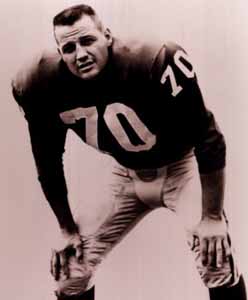
Sam Huff
Top of Page |
Reference: "Much Like Favre, Huff Was Yanked from Roots," New York Times, August 10, 2008 |
|
Big Thursday
"In South Carolina, it is unpardonable for a red-blooded citizen to be neutral on Big Thursday. On that momentous day, by decree of state law and with the State Fair as a backdrop, Clemson College (enrollment 3,200) fights it out on the football field with the University of South Carolina (enrollment 4,000). As usual last week, schools closed down and politicians scurried back from Washington as citizens began working themselves into the mood for the 47th annual battle."
Thus began a 1949 Time article on the SC-Clemson game, which was played every year from 1909-1959 on the Thursday morning of State Fair weekend in Columbia. Here are some interesting occurrences during the rivalry from the article and other sources.
- "There had been friction between the two factions since the day Pitchfork Ben Tillman, the state's rip-snorting governor of the 1890s, branded the university as a center of snobbery and helped found Clemson, a "heman" agricultural college with a strong emphasis on military training."
- "In 1902, the Clemson cadet corps showed up for the game with drawn bayonets." After the Gamecocks upset Coach John Heisman's Tigers, a riot broke out. The Carolina fans sported a poster that inaugurated their new mascot. It showed the image of a tiger with a gamecock standing on top of it, holding the tiger’s tail as if he was steering the tiger by the tail. Understandably, the Clemson guys objected, and sporadic fistfights involving brass knuckles and other objects broke out the day before and the morning of the game. After the game, the Clemson students warned their Carolina counterparts not to bring the poster to the big parade on Friday. This threat, of course, had the opposite effect.
So another brawl broke out before both sides agreed to burn the poster. However, the schools stopped playing each other until 1909.

1929 Big Thursday game
- Cary Cox played for Clemson in their 18-6 victory in 1942. Then he signed up for the V-12 program and was placed at USC (which means University of South Carolina on the East Coast). His naval instructors ordered him to play on the football team, and he was named captain for the 1943 Big Thursday clash against his former team. Cox confessed his reluctance to his coach, Lt. James P. Moran, who responded: "Cox, I can't promise you'll get a Navy commission if you play Thursday, but I can damn well promise that you won't get one if you don't play!" So Cox led the Carolina team to a 33-6 win against his former team. He returned to Clemson after the war and captained the 1947 team in a losing effort to Carolina. So Cox ranks as the only player to captain both schools' football teams.
- "In 1946 the Great Day splashed over into a riot." Counterfeit tickets were sold, and fans with legitimate and fake tickets were not allowed inside once the stadium filled. So they stormed the gates and were eventually allowed to stand along the sidelines. To add to the wild scene, a Clemson fan strangled a live chicken at midfield during halftime. Two distinguished attendees, U.S. Secretary of State James F. Byrnes, future governor of South Carolina, and Senator Strom Thurmond, settled down the hostile crowd. Carolina won 26-14.
- "For 24 hours before the game last week [1949], the bell on the university chapel clanged without letup. At dusk on Big Wednesday, the Clemson Tiger was burned in effigy on the State House steps ... except for a few Carolina enthusiasts who lobbed rotten tomatoes and grapefruit rinds at Clemson cars, the partisans were on their good behavior."
- In 1961, a USC fraternity pulled off the greatest prank in the rivalry's history. A few minutes before Clemson team entered the field for pre-game warm ups, a group of frat boys ran onto the field, jumping up and down and cheering in fake Clemson uniforms. This caused the Clemson band to start playing "Tiger Rag." When the pranksters fell down during calisthenics, dropped passes, and missed the ball when trying to kick it, Tiger fans realized that they had been had, and some angrily ran onto the field. However, security restored order before a fight broke out. Carolina won 21-14, when Clemson ran out of time on the Gamecock one-yard-line.
Returning to 1949, 35,000, the biggest crowd ever at a sporting event in South Carolina to that time, gathered to watch the 0-3 Gamecocks of Coach Rex Enright take on the 2-1-1 Tigers of Frank Howard. When his Cocks fell behind 13-0, Enright's job appeared to be on life support. Then SC's star HB Steve Wadiak breathed some life into his team by running back a kickoff 60y to set up a TD. By halftime, the game was tied, 13-13. As Enright's players ran in and out of the game, they told him: "Coach, they're wilting!"
Carolina dominated the second half. QB Bo Hagan threw a 40y pass for the lead and led another TD drive for a 27-13 victory. At game's end, his players carried good ol' Rex off the field on their shoulders. His job was saved for at least another year. (SC finished '49 at 4-6, and Enright lasted through1955.)

Reference: "Big Thursday," Time, October 31, 1949 | Top of Page
|
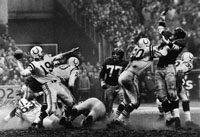
Johnny Unitas passing against the Giants.
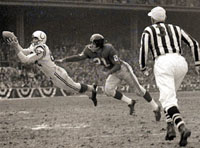
Raymond Berry
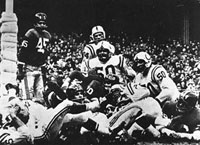
Action during the 1958 NFL Championship Game
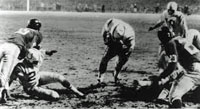
Alan Ameche scoring the winning TD
|
The 1958 NFL championship game was in overtime. QB Johnny Unitas was marching the Baltimore Colts into New York Giants territory for the winning score. He had just completed a slant across the middle to WR Raymond Berry to the eight. It was Berry's twelfth catch of the game.
As a record TV audience watched across the country, NBC suddenly lost its connection and all sets went black.
- The patrons at Henry Mack's pub in Glen Burnie MD started throwing things at the set. Henry stood between the rowdies and his precious TV, trying to protect it.
- Joey Radomski, a dockworker in Locust Point MD, was watching the game with his 18-year-old daughter, who was praying the rosary throughout. Radomski got up and banged the top of the set. When the picture did not return, he swore like the dockworker he was, undoubtedly cancelling his daughter's prayers to the Blessed Virgin.
- In a novitiate in the Baltimore area, the nuns-in-training, who were watching in defiance of Church regulations requiring novices to have no contact with "the world," worried that their disobedience had brought down God's wrath.
- In an affluent Baltimore suburb, the poet Ogden Nash and his wife Frances, who watched with four generations of Nashes, shouted curses while scurrying to find the newly-antiquated device, a radio. Several family members argued vociferously over which station was carrying the game. "Our behavior was something absolutely appalling," said Nash's daughter later.
Meanwhile, back at Yankee Stadium, NBC technicians quickly discovered the source of the problem. Someone in the crowd on the field behind the end zone had kicked the network's cable. As the Colts broke the huddle to line up for what might be the winning TD, the NBC directors in the press box were frantic. In those newlywed days of tv and football, networks couldn't stop the action for commercials whenever they wished. Amazingly, however, NBC had developed an emergency plan based on an article in the New York Times two months earlier. A CBS sports producer had speculated about what his network might do to stop the action in a pinch. "Maybe we could cue a drunk to go out and interrupt things," he told the Times reporter.
Fans listening on the radio heard the announcer say, "Play will be held up now. A fan's running out on the field with three of New York's finest trying to corner him." The young man gave the cops a good run, covering most of the length of the field before being corraled by reinforcements from the end zone away from the action. Newspaper reports the next day referred to the "drunk" who interrupted the contest at a crucial moment. But the man wasn't tipsy at all because he had been working, not drinking. He was Stan Rotkiewicz, a business manager at NBC news, who worked as a statistician during football broadcasts. He had bolted onto the field on cue from the tv director. The ruse worked, giving technicians just enough time to replug the cable.
Sets sprang back to life all over the U.S. No one had missed a play. When the game resumed, Baltimore scored the winning TD in two plays.
Reference: The Best Game Ever, Mark Bowden
|
USC-ND Part I – Rockne vs Jones
The most storied intersectional series in the country is Notre Dame-Southern California.
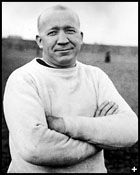
Knute Rockne |
- The series began with a gentlemen's agreement at midfield after Iowa upset Notre Dame 10-7 in 1921 (ND's only loss in eleven games that season). When Knute Rockne shook hands with Hawkeye coach Howard Jones at the end of the game, he made Jones promise to play ND again. When Howard moved to USC for the 1925 season, he made good on his promise and the game has been an annual event since 1926 except for three years during World War II when travel restrictions prevented it.
- The game was the first regular season contest for which a Midwest team traveled to the West Coast. As such, it was a publicist's dream, an opportunity to gain media coverage at cities along the train route. Rockne, a "promotional genius," would schedule daily stops for the team to work out. This gave him the opportunity to talk to the local press.
|
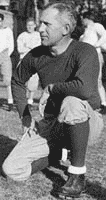
Howard Jones |
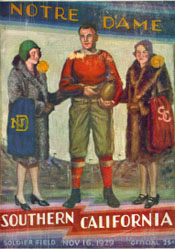 |
- In 1927, the Trojans traveled to Chicago to meet the Irish at Soldier Field. The crowd of 120,000 broke the record of 110,000 set the year before at the same stadium for the Army-Navy clash. ND won 7-6. In the previous year's inaugural in Los Angeles, the score was 13-12 Irish. Any doubts about whether this would be an epic series were already dispelled: two games, two one-point squeakers.
- 1929: ND hosted USC at Soldier Field. As the crowd of 112,912 gathered, Irish coach Knute Rockne was nowhere to be found. His players were told he was in bed with leg problems. At halftime, with the score tied 6-6, Rockne dramatically entered the locker room in a wheelchair. He gave one of his patented speeches, concluding: "Play them hard. Rock will be watching you." ND squeaked out another one-point win, 13-12. Knute may have been incapacitated or maybe not. A shyster, not a saint, he was known to "stretch the truth" for effect.
Reference: Football Feuds: The Greatest College Football Rivalries, Ken Rappoport & Barry Wilner
Top of Page |
|
|
USC-ND Part II – McKay vs Parseghian
Perhaps the greatest coaching matchup in the rivalry was that between Ara Parseghian at ND and John McKay at SC. In Parseghian's eleven years in South Bend, nine SC games had national importance. The winner won the national championship five times. Ara: "We had an intense rivalry and virtually every year each team came into the game having an influence on the national championship in one way or another. It was incredible." McKay was 6-3-2 against Parseghian. But each experienced the highest of highs and lowest of lows against the other.

Ara Parseghian

John Huarte
|
- 1964: Parseghian's first crack at USC. His Irish were 9-0 and ranked #1. They built a 17-0 halftime lead behind QB John Huarte, who would win the Heisman Trophy. But the Trojans rallied to pull out a 20-17 victory when Rod Sherman caught a TD from Craig Fertig with 1:33 remaining at the Coliseum. Fertig: "Coach McKay was really emotional. Notre Dame was his favorite team as a kid, so he made the Notre Dame game really important."
- 1974: Deja vu all over again, to quote Yogi Berra. ND held a 24-0 lead shortly before the half, only to have the Trojans score 55 unanswered points in less than 17 minutes. Anthony Davis scored 4 TDs, including a return of the second half kickoff. When asked later what McKay had told the team at halftime, QB Mike Sanford said, "He turned the lights out so you could think about the game. His only comment was, 'Gentlemen, we're behind.'" Davis, ND's greatest tormentor of all time, had scored 6 TDs two years earlier in a 45-23 victory that completed a perfect season. So you can understand why AD was Public Enemy No. 1 to Irish fans. Davis: "After that '74 game, I was walking out of the locker room. There were about 20 Irish fans milling around and one of them, this lady, walked up to me. I don't know if she was serious or not, but she pulled out a small crucifix on a chain and started swinging it in my face. ... 'Nobody's ever done that to Notre Dame, AD. You've got to be the devil.'"
- 1966: Coming off the infamous tie against Michigan State, ND came to Los Angeles and clobbered the Trojans 51-0 to regain the #1 ranking. Jim Seymour, ND All-American end: "Before that game, Ara came into the locker room and wasn't like himself. Normally, he would leave the players completely alone, except maybe talking to the QBs or receivers. But this time ... after we knelt down in prayer, he went over to the blackboard and wrote down '1964' and circled it and said, 'Let's go.'" Interestingly, ND had won in '65 28-7 to seemingly slake their vengeance. McKay never forgot that merciless beating in '66.
|

John McKay

Anthony Davis
|
Reference: Football Feuds: The Greatest College Football Rivalries, Ken Rappoport & Barry Wilner
|
|
"You Can't Stay on Our Team"

Milt Davis
Top of Page |
Milt Davis, an All-Pro DB on two Baltimore Colts NFL champion teams, died September 29, 2008.
Davis played for Baltimore from 1957-60. He led the NFL in interceptions in '57 and '59. In the famous 1958 championship game against the New York Giants, he played with two broken bones in his right foot but forced a first-half fumble by Frank Gifford. His salary that season was $7,000. He retired after the 1960 season because he was tired of the racism against black players and wanted to finish his doctorate at UCLA, where he played college ball, including the 1954 Rose Bowl.
Milt was drafted in the eighth round in 1954 by Detroit. However, he had to serve two years in the military first. When he finally joined the Lions, he was told, "We don't have a black teammate for you to go on road trips. Therefore you can't stay on our team."
After a tryout, the Colts signed him as a 28-year-old free agent. He had 10 INTs as a rookie, returning two for TDs, to make the All-Pro team. He ended his career with 23 INTs.
After retirement, Davis scouted college players for NFL teams and taught high school in the Los Angeles area before becoming a natural history professor at Los Angeles City College.
|
|
|
Don't Kid in the Showers
The Duluth Eskimos were one of the most colorful teams in NFL history and the inspiration for the movie "Leatherheads." The team competed in the league from 1923-7. Here is one of the many stories about the team.
Howard Kiley and Art Juntilla played next to each other on the Duluth line. Juntilla was also a middleweight fighter under the name Young Sharkey. The two were constantly dissing each other. Kiley said Juntilla wasn't as dumb as an ox but wasn't any smarter either. He also told Juntilla, "Your face would make a good blueprint for an idiot." Juntilla retorted, "I've seen better looking pans than yours under ice boxes."
The McKay Hotel across the street from the team's gas-lit practice field served as clubhouse, training quarters, and dressing room. One day, the players were showering in the hotel. The manager passed around the program for the next game. Juntilla noticed the initials C.H. in front of his name and asked why. "They stand for Cement Head," said Kelly. Juntilla could take no more. He swung at Kiley and chased him outside and down the street. Neither seemed to realize that he was naked! Kiley hid in the bushes, and Juntilla returned to the locker room. Later, another player took a robe and slippers to Kiley so he could walk back to the hotel.
Reference: Leatherheads of the North: The True Story of Ernie Nevers & the Duluth Eskimos, Chuck Frederick
Top of Page |
|



















